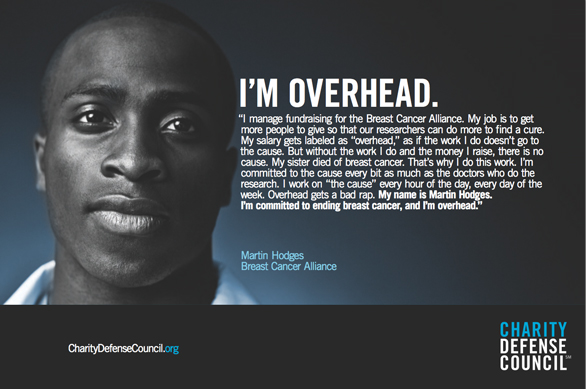June 2013 was a shocking month for Dan Pallotta, in a good way. “I thought I was living in an alternate universe or something,” he says. “It was like hell freezing over.”
Two things happened in June that Pallotta never expected to see. First, this gay father of triplets saw the United States Supreme Court strike down a key part of the Defense of Marriage Act, recognizing legally married same-sex couples. Second, he saw three of the largest charity-rating organizations in the U.S. join forces to counter what they called “The Overhead Myth.” To understand why Pallotta calls this “a huge, huge deal” we need to back up a bit.
At TED2013, Pallotta gave a powerful talk asking the public to rethink their assumptions about charities. Pallotta shared the story of his own nonprofits — AIDSRides bicycle journeys, which raised $236 million for HIV/AIDS over a period of nine years and Breast Cancer 3-Days, which raised $333 million for breast cancer over a period of five years. Both went out of business because of public outrage that his organization spent 40% of its gross on so-called “overhead”—things like staffing, marketing and creating a great experience for those who participated. Pallotta says the backlash was a result of a fundamental assumption about charities: That they are supposed to keep overhead low. But as Pallotta says in his talk, this is not a standard that businesses are held to. He wonders: Could a charity grow to a size big enough to tackle a problem by investing in great talent, in advertising and marketing and in new ideas?
The talk got the TED2013 audience talking, and it was posted on TED.com 10 days later. Pallotta quickly began receiving tons of emails — from those inside the nonprofit world and outside it.
Three months after his talk went live, Pallotta was surprised to see GuideStar, Charity Navigator and the Better Business Bureau Wise Giving Alliance — three leading resources for nonprofit data in the US — announce that they were “denouncing the ‘overhead ratio’ as a valid indicator of nonprofit performance.”
In an open letter to donors, the presidents and CEOs of these three organizations wrote: “We write to correct a misconception about what matters when deciding which charity to support. The percent of charity expenses that go to administrative and fundraising costs—commonly referred to as ‘overhead’—is a poor measure of a charity’s performance. We ask you to pay attention to other factors of nonprofit performance: transparency, governance, leadership, and results.”
Pallotta cannot be sure if his talk was a factor in these three organizations taking this step, which included establishing OverheadMyth.com. But the timing was exciting.
“I could not have dreamed that the issue that put our company out of business would make a 180-degree turn. It was just something that nobody questioned,” says Pallotta. “I would’ve had to have given speeches every day, three times a day, for something like the next 30 years of my life to reach as many people as I’ve reached with TED. The high production values, the 18-minute format, the strength of the TED brand, and boom. All of the sudden people listen to something that you’ve been screaming from the mountaintops for four years.”
As Pallotta is careful to establish, this issue is nowhere near case-closed. “We’ve got a long way to go. The average member of the general public still thinks you ask about overhead,” he says. “But at the level of the leadership of the sector, it’s really beginning to change very quickly.”
Pallotta also credits the talk with another step forward. For years, Pallotta has had the idea for a Charity Defense Council, an organization to look out for the well-being of the sector at large. Propelled by the reaction to his talk — and hearing from people that they wanted to do something — he decided to make it a reality.
The Council will serve multiple purposes. It will do anti-defamation work, stepping in to respond to negative media reports. It will perform legal defense work, advocating against legislation that would have negative effects on the nonprofit sector. (An example, says Pallotta, is legislation to cap executive pay for nonprofits — like Andrew Cuomo proposed in New York in 2012 — since it means the sector can’t compete with big business.) The Council will also aim to organize the sector, creating a database of the employees in it. The Council is steered by an advisory board made up of high-profile thinkers in the nonprofit world like Mark Tercek of The Nature Conservancy, Stacey Stewart of United Way and Art Taylor of the BBB Wise Giving Alliance.
Through the Charity Defense Council’s website, about 1,000 people have signed up to donate time and energy to the project, says Pallotta. Meanwhile, the Council has received $150,000 in funding, which is being used to hire its first three staff members. They will start in the next five to seven weeks.
But the function of the Council that Pallotta is perhaps most excited about: serving as an ad agency for the non-profit sector at large.
“The entire nonprofit sector has never taken out a full-page ad in The New York Times to say, ‘Hey, public. Here’s another way to think about overhead,’” says Pallotta. “What we would do is take a tactic from the pork industry, or the milk industry, or the egg industry. Milk has ‘Got milk?’ Eggs have ‘The incredible edible egg.’”
So what is the nonprofit sector’s version of this? One of the first concepts that the Charity Defense Council is working on features a person looking in the camera and saying, “I’m overhead.”

“We can humanize this thing called overhead. Because overhead is people,” says Pallotta. “It’s people who are passionate about these issues.”
A year after his talk, Pallotta sees his mission from here on in to keep communicating to the public that charities should be empowered to use business practices to scale. Delivering this message is powerful, he says, and can have big implications on the personal level. For example, he shares a recent email from a woman who worked in biotechnology for years and recently made the switch to a small nonprofit, one especially meaningful to her because it promotes research for a disease that affects a family member.
“I’m writing to you because while there were many factors that led me to make this jump, there was one, critical factor that made it possible: my salary. When [this nonprofit] asked what it would take for me to leave my corporate job and consider the position, I said I would need to continue making my current salary. I never would have even *thought* to ask for this if it weren’t for your TED talk. But I asked. And they gave it to me … So thank you. It is a wonderful thing to have passion and purpose supported by a competitive paycheck.”












